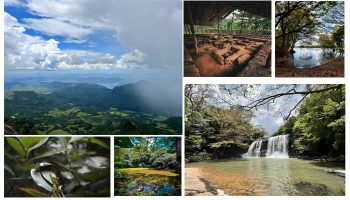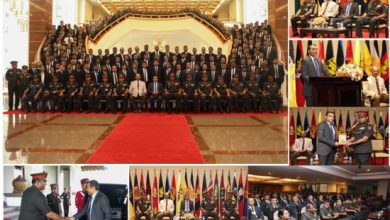Transforming Tourism
Revitalizing Sri Lanka’s Tourism to be a Resilient & Inclusive Industry

A serene mist envelope an ocean of luscious greenery and hills, deep in the depths of a stillness that is synonymous with the Sri Lanka’s highlands. About 180 kilometers away from the hustle of the capital city Colombo, so lies Riverston, part of the Knuckles Mountain Range—a popular nature trail and hike among the island’s many tourist destinations, and one of the many project sites that falls under the European Union (EU) funded, ‘Transforming Tourism in Sri Lanka: Emerging from crisis as a strong, resurgent and rebranded industry’ project.
A series of challenges
Sri Lanka’s tourism sector has been subject to a series of challenges since the 2019 Easter Sunday Attacks, followed by the protracted impacts of the COVID-19 pandemic, and now, the economic crisis. The impacts of these crises, especially the pandemic, brought to light a host of challenges that continue to compound hardships of the most vulnerable populations that engage in the tourism industry. The island does have a penchant for coming together in tough times, for resilience and recovery. However, given the importance of tourism to those at various levels of society across the island and the economy, it was evident that the sector needed more support to sustain and grow.
With the core need of putting people first in mind, the United Nations Development Programme (UNDP) in Sri Lanka with financial assistance from the European Union (EU), conducted a ‘Rapid Assessment on the Impacts of COVID-19 on the Tourism Sector’. The assessment found: a) limited intra-governmental coordination, and sub optimal mechanisms to promote the tourism sector; b) limited priority given to the tourism sector at the provincial and local level; and, c) limited engagement of stakeholders and partners in policy and product development to be some of the key structural issues that prevent the industry from a reaching a faster recovery and increasing resilience of the sector.
Transforming Tourism
In this context, to address the barriers identified in the assessment, with financial support from the EU, and in partnership with the Ministry of Tourism and the Sri Lanka Tourism Development Authority (SLTDA), the ‘Transforming Tourism’ project was launched. The project’s central focus is to support the Government of Sri Lanka to revitalize and reform the core structures that support tourism—governance, institutions, policy mechanisms, tourism products and promotion, sectoral transformation and financing—to create a more sustainable industry for people and the planet. The Project works towards transformative change in the industry, and to create tourism that is resilient, sustainable, inclusive and to be equipped to bounce back swiftly to generate returns across the whole economy, both for the betterment of the two million people that engage in tourism, and the country.
With the Ministry of Tourism and the SLTDA at the helm, and with technical and financial assistance from UNDP and the EU, the policy framework and the institutional capacities of the tourism sector actors were assessed and strengthened. A key output of this intervention was the support provided to the government partners to develop the National Tourism Policy. The implications of these higher-level, technical efforts can be witnessed on the highlands of the island, in the Central Province.
Hidden Treasures
Between the evergreen, mist laden mountain ranges of Riverston-Knuckles and the infamous rock fortress Sigiriya, value chain and carrying capacity assessments, analysis on product diversification and upgrading potential, and the pilot testing of innovative and upgraded tourism products are underway to establish gender-sensitive experiences and services. The interventions are also being reinforced by a promotional campaign that characterizes the myriad of attractions within the Central Province. In Sigiriya alone, apart from the rock fortress that is known the world over, there is an abundance of lesser-known attractions that hold promise of drawing in more tourists. Across the province, there are around forty attractions including Pathana, Sera Ella, Bambarakiri Ella, Weddapeni Ella, surrounding Riverston. And, more closer to Sigiriya, there is a plethora of sites like the Ibbankatuwa Burial Site, Kaludiya Pokuna, Ritigala and much more that can increase visitations and augment tourism income for the province.
The ‘Transforming Tourism’ Project works towards building a transformed, competitive and resilient tourism sector, with requisite polices and institutional capacities to deliver unique and sustainable tourism experiences. With two million people depending on the island’s beaches, mountains and unique biodiversity to sustain their livelihoods, the support provided helps address structural governance issues that lays the foundation for more resources to be mobilized for the betterment of the industry, across the island. Particularly, the ongoing economic crisis further calls for more innovative approaches to tourism, to leverage the benefits that Sri Lanka’s natural resources offer. The gender-sensitive tourism products in the Central Province serves as a blueprint for the rest of the island to transition to sustainable tourism that promotes environmental conservation and also bring sustainable development gains to local communities.
Driving Sustainable Development
Tourism has the incredible power and potential to advance prosperity and drive inclusive, sustainable development. The tourism sector touches almost every part of our economies and societies, enabling historically marginalized people and those at risk of being left behind to benefit from development that is local and direct. Sri Lanka is at a critical juncture, and, leveraging the current crisis to bounce back towards a greener, sustainable and environmentally conscious tourism offering outlines the country’s pathway to green development.






